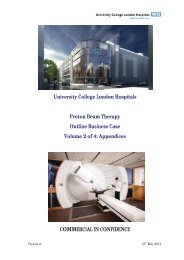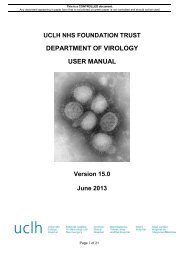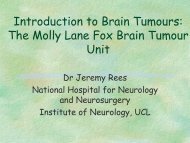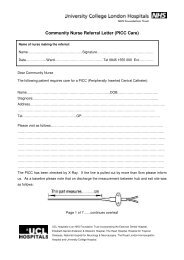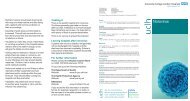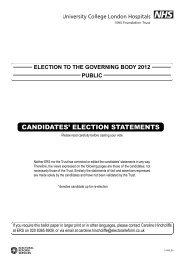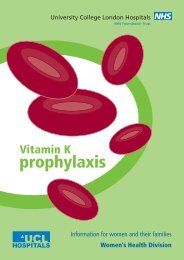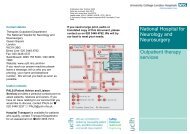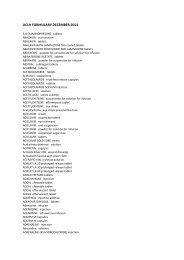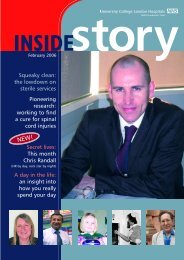INSIDE STORY SEP10.ps, page 5 @ Preflight
INSIDE STORY SEP10.ps, page 5 @ Preflight
INSIDE STORY SEP10.ps, page 5 @ Preflight
You also want an ePaper? Increase the reach of your titles
YUMPU automatically turns print PDFs into web optimized ePapers that Google loves.
Inside Story<br />
Positive response for blood dispenser – <strong>page</strong> 2<br />
AND<br />
A new dawn for integrated medicine – <strong>page</strong>s 4 & 5<br />
PLUS<br />
Secret lives: ‘I swam The Channel!’ – <strong>page</strong> <br />
Inside Story is the UCLH staff magazine
news<br />
Blood on tap<br />
Quicker, safer, cleaner and greener – a<br />
new system launched at The Heart<br />
Hospital brings supplies of donor blood<br />
closer to the patients that need it.<br />
Rather than keeping all supplies of<br />
Karine Pearson, anaesthetic coordinator,<br />
getting blood from the Hemosafe<br />
blood off site, The Heart Hospital now<br />
has an automatic system called a<br />
Hemosafe where blood is dispensed<br />
vending machine-style.<br />
Jenny Berryman, blood transfusion<br />
laboratory manager, said: “This will<br />
completely transform the way we<br />
access and use blood. The Hemosafe<br />
will be stocked with all blood types and<br />
because it is there on site, staff will be<br />
able to take what they need without<br />
worrying that they are requesting too<br />
much or too little – this should mean<br />
less wastage.<br />
“As soon as the group and screen<br />
sample testing is completed by the<br />
laboratory and as long as the patient<br />
has no antibodies, blood can be<br />
dispensed by the fridge as needed.”<br />
Only trained staff will be able to use it<br />
and because the system is fully<br />
automated there will be an audit trail<br />
enabling the laboratory to see who has<br />
taken it, when it was used and how<br />
much was used. This will mean an end<br />
to filling in paperwork and will free up<br />
more time for staff to deliver patient<br />
care.<br />
Dr Daniel Farrar, consultant<br />
anaesthetist and chair of the hospital<br />
transfusion committee, said: “With the<br />
Hemosafe there is no chance of picking<br />
up the wrong bag of blood – this helps<br />
us comply with regulatory requirements<br />
and makes the transfusion process<br />
safer for patients.”<br />
The Hemosafe will also quarantine any<br />
bags of blood that are returned to the<br />
machine so that ‘old’ blood, or blood<br />
kept out of the fridge greater than 30<br />
minutes, cannot be used.<br />
The Hemosafe is undergoing a pilot<br />
trial at The Heart Hospital and if it is<br />
successful it is planned to install the<br />
remote issue blood fridges at all sites<br />
across the Trust by next summer.<br />
Stop the clots<br />
Clinical staff are being asked to<br />
help improve the safety of patients<br />
by assessing the risk of venous<br />
thromboembolism (VTE) and<br />
ensuring appropriate measures<br />
are taken for those at higher risk<br />
of developing clots.<br />
VTE is preventable but kills at<br />
least 25,000 patients across<br />
England every year. Reducing the<br />
risk of VTE is top of the NHS<br />
safety priorities for 2010/11.<br />
All patients should undergo a VTE<br />
risk-assessment on admission to<br />
hospital, and this should be<br />
recorded on the relevant section of<br />
the patient’s drug chart. Patients<br />
at increased risk of developing<br />
VTE are given blood-thinning<br />
injections of heparin and where<br />
appropriate, a pair of compression<br />
stockings to help blood flow<br />
through the veins.<br />
As the risk of clots can change<br />
during the hospital stay, patients<br />
should have the assessment<br />
repeated after 24 hours and<br />
regularly during the hospital stay.<br />
The Trust VTE risk assessment<br />
tool is available on Insight, copies<br />
have been placed in all end-of-bed<br />
folders and it is now available in a<br />
credit card style for all clinical staff.<br />
Dr Hannah Cohen, consultant<br />
haematologist and chair of the<br />
Trust haemostasis and thrombosis<br />
committee, said: “Correct risk<br />
assessment and VTE prophylaxis<br />
could save thousands of lives<br />
across the UK.”<br />
Dr Robert Urquhart, divisional<br />
clinical director clinical support, is<br />
chairing a Trust VTE strategy<br />
group.<br />
Robert said: “Our monthly audits<br />
of VTE risk assessments<br />
demonstrate that we are making<br />
progress. However, there is still a<br />
lot of work to do to deliver on this<br />
important patient safety target. It is<br />
the responsibility of all clinical staff<br />
to ensure that we implement all<br />
the steps to minimise the<br />
avoidable harm that VTE can<br />
cause to our patients.”<br />
Dr Hannah Cohen and Dr Robert Urquhart display the<br />
tools available in preventing VTE<br />
Contact Us<br />
If you have any information you would like included in Inside Story, or on the Trust intranet site<br />
Insight, contact: Communications Unit, 2nd Floor Central, 250 Euston Road, London NW1 2PG.<br />
Email: communications@uclh.nhs.uk, Tel: ext 9897, Fax: ext 9401.<br />
Front cover: Karine Pearson,<br />
anaesthetic coordinator at The<br />
Heart Hospital<br />
2
news<br />
Preserving a moment in time<br />
Photographs, patient stories, historical<br />
documents and details of the latest research and<br />
treatments available on the NHS were preserved<br />
for centuries in a time capsule buried in the<br />
depths of the UCLH Cancer Centre in a special<br />
ceremony last month. The box was buried within<br />
the structure of what will be an operating theatre<br />
on the lower ground floor of the new<br />
development, which is on schedule to open in<br />
April 2012.<br />
The cancer centre exhibition has been<br />
updated to reflect the progress of both the<br />
construction of the centre, and efforts to<br />
improve the patient experience through new<br />
ways of working. To arrange a viewing,<br />
please contact Olivia Mulholland via email.<br />
Dates for your diary<br />
The Annual Public Meeting is being held on 30<br />
September in the Education Centre at 6pm.<br />
The chief executive roadshows are taking place in<br />
October.<br />
All roadshows take place between 12 midday and<br />
2pm. Check Insight for further details.<br />
Charity partners including Macmillan Cancer Support represented by their<br />
development manager Helen Liles (centre, flanked by chief executive Sir Robert<br />
Naylor and Frank Dobson MP) buried a little bit of history about their organisations<br />
which will be preserved for generations to come.<br />
Chief executive roadshows:<br />
14 October<br />
18 October<br />
21 October<br />
26 October<br />
28 October<br />
The Heart Hospital<br />
NHNN and RLHIM<br />
UCH, EGA, HTD and 250 Euston Road<br />
UCH, EGA, HTD and 250 Euston Road<br />
The Eastman Dental Hospital<br />
Turbo booster aids recovery<br />
Patients at UCH are the first in the<br />
country to benefit from the latest laser<br />
technology which unclogs leg arteries<br />
in a matter of minutes.<br />
Short bursts of laser energy blast the<br />
obstructing tissue into microscopic<br />
particles that are absorbed into the<br />
bloodstream – restoring natural blood<br />
flow and bringing rapid relief from<br />
pain, without the need for complex<br />
bypass surgery.<br />
The ultraviolet light is transmitted<br />
through flexible glass fibres which are<br />
guided into place by a catheter which<br />
is advanced through the blockage.<br />
Excimer laser technology with Turbo<br />
Elite® is highly effective for patients<br />
who have developed total blockage of<br />
Members of the multi-disciplinary endovascular team (MET) (l-r): Dr Joe Brookes, clinical director<br />
for imaging and vascular services, Sean Fowler, senior radiographer, Babrah Mohammed, senior<br />
radiographer, Alfred Tan, senior staff nurse, and Dr Julian Hague, imaging and consultant<br />
radiologist.<br />
arteries following previous angioplasty<br />
or stent placement (a minimally<br />
invasive technique to widen narrowed<br />
arteries).<br />
Dr Joe Brookes, vascular radiologist<br />
and divisional clinical director for<br />
imaging and vascular services, said:<br />
“If patients develop a scarring reaction<br />
following angioplasty or stent<br />
placement, unwanted tissue can begin<br />
to build up on the artery wall which<br />
constricts them again. Obviously this<br />
puts the patient at further risk.<br />
“This latest procedure is a very simple<br />
and effective way of vaporising the<br />
tissue in a controlled way to get the<br />
blood flowing freely again. UCH is the<br />
only hospital in the country to offer this<br />
procedure and several of our patients<br />
have already benefited.”<br />
Previously, the options available to<br />
treat blockages in the pelvis and legs<br />
were limited to further attempts at<br />
angioplasty or stenting with<br />
disappointing long-term results,<br />
ultimately leading to bypass surgery.<br />
3
RLHIM focus<br />
A new dawn for integrated medicine<br />
This month marks a landmark in the<br />
history of the Royal London<br />
Homoeopathic Hospital with the<br />
announcement that its name has<br />
changed to better reflect the range of<br />
services it provides.<br />
The hospital will now be known as the<br />
Royal London Hospital for Integrated<br />
Medicine (RLHIM).<br />
The change was recommended by<br />
senior staff at the hospital and approved<br />
by the UCLH board of directors.<br />
For more than ten years the hospital has<br />
explicitly focused on integrated medicine<br />
and has long been the UK’s leading<br />
centre for this approach. It is the largest<br />
public sector centre for integrated<br />
medicine in Europe.<br />
For many years after its foundation in<br />
1849 it was a general hospital including,<br />
for instance operating theatres and<br />
surgical wards, and a specialist<br />
homeopathic department. From the<br />
1980s the surgical and other<br />
conventional specialities were replaced<br />
by a wide range of complementary<br />
medicine services including the NHS’s<br />
first complementary cancer care,<br />
acupuncture, musculoskeletal medicine<br />
and herbal medicine services. Work<br />
around the name change has been<br />
supported by UCLH Charity.<br />
Dr Peter Fisher, the hospital’s clinical<br />
director, explains more.<br />
1. What was the driving factor behind<br />
the name change?<br />
“Interest in our services is growing all<br />
the time and our name change<br />
reflects the integration of<br />
complementary and conventional<br />
disciplines.<br />
“For several years, fewer than a<br />
quarter of patients attending the<br />
hospital have received homeopathy<br />
only.<br />
“The name change reflects the<br />
hospital’s role in bringing together<br />
safe, effective, high quality<br />
complementary and conventional<br />
medicine, emphasising the<br />
importance of the doctor-patient<br />
relationship and seeing patients as<br />
active participants, making choices<br />
about their healthcare and lifestyle.”<br />
Some members of the senior team at the RLHIM<br />
2. Will you still continue to offer<br />
homeopathy?<br />
“We will continue to provide it as long<br />
as patients choose it and it is<br />
commissioned. Homeopathy is an<br />
integral part of integrated medicine. At<br />
present there is strong patient<br />
demand for homeopathy and in an<br />
era of patient choice we are providing<br />
a service that meets that demand.”<br />
3. What is integrated medicine?<br />
“It means putting together the best of<br />
complementary medicine and<br />
conventional medicine to deliver the<br />
best outcomes for patients.<br />
“We work very closely with clinical<br />
partners across UCLH to improve the<br />
patient experience and clinical<br />
outcomes.<br />
“We have developed unique<br />
integrated clinical services including:<br />
an integrated pain service in<br />
collaboration with the Eastman Dental<br />
Hospital and National Hospital for<br />
Neurology and Neurosurgery,<br />
providing acupuncture, hypnotherapy,<br />
homeopathy, and autogenic training<br />
to complement conventional<br />
pharmacological treatments.<br />
“Among many examples of<br />
innovation, the hospital introduced<br />
acupuncture into the NHS as long ago<br />
as 1977. Acupuncture is now<br />
recommended by NICE for the<br />
treatment of low back pain.”<br />
4. What next for the RLHIM?<br />
“We’re really excited about what the<br />
future holds for our newly-named<br />
hospital. We will continue to lead the<br />
way in innovation for integrated<br />
medicine and provide safe and<br />
effective treatments for common,<br />
problematic conditions. Among our<br />
recent innovations are weight loss<br />
and insomnia clinics.<br />
“We have established group<br />
acupuncture clinics, a cost-effective<br />
way of providing acupuncture and set<br />
up the NHS’s first musculo-skeletal<br />
medicine service. The hospital has<br />
among the highest positive patient<br />
feedback scores in the NHS and we<br />
are determined to build on this<br />
success.”<br />
4
Cancer care – an integrated approach<br />
An integrated approach to caring for those<br />
with cancer appears to have speeded up<br />
the recovery process for patients such as<br />
Martyn Goldsmith. "The results have been<br />
absolutely unbelievable – it has worked<br />
beautifully," he said.<br />
As well as conventional chemotherapy and<br />
radiotherapy to treat cancer of the left tonsil<br />
and lymph nodes, Mr Goldsmith benefited<br />
from homeopathic medicine and<br />
acupuncture at the RLHIM which<br />
dramatically reduced the unpleasant sideeffects<br />
he experienced, such as reduced<br />
saliva and difficulty in swallowing.<br />
He said: "I had about 20 fine hair-thin needles<br />
placed on the edge of my ear, in my cheek and<br />
index finger. I had an open mind about it – I just<br />
wanted to get better as fast as possible.<br />
"Following just a few acupuncture sessions<br />
there was a marked improvement. After a few<br />
weeks I was eating solids without difficulty!"<br />
Western medical acupuncture is believed to<br />
directly stimulate local nerves around the<br />
salivary glands which improve the function of<br />
the damaged tissue.<br />
Consultant oncologist Dr Dawn Carnell, who<br />
oversaw his chemoradiation treatment, said:<br />
"Patients need great physical and psychological<br />
reserves to complete the treatment and then<br />
RLHIM focus<br />
Martyn receiving acupuncture from Dr Santosh Patil, dental<br />
acupuncturist<br />
rehabilitate from the side effects. We often<br />
utilise complementary medicine alongside<br />
conventional therapy to facilitate this."<br />
Martyn was referred to Dr Sosie Kassab,<br />
director of the Complementary Cancer Service<br />
which offers homeopathy, Iscador (mistletoe<br />
preparation), acupuncture, autogenic training,<br />
relaxation and visualisation, hypnotherapy,<br />
cognitive behavioural therapy, therapeutic<br />
massage and aromatherapy, reflexology, reiki,<br />
art therapy and dietary advice.<br />
Sosie said: "We aim to use complementary<br />
treatments safely and appropriately alongside<br />
conventional management and guide patients<br />
to sources of high quality information about<br />
effectiveness and safety."<br />
Autogenic training – ‘it worked for me!’<br />
Katherine with her daughter Thea<br />
After previously suffering a series of<br />
miscarriages, Katherine Small felt<br />
the joy of being pregnant again was<br />
completely overshadowed by<br />
mounting anxiety.<br />
She said: “I felt tearful and<br />
exhausted and I was starting to<br />
suffer from panic attacks and<br />
sleeplessness.”<br />
Mrs Small was referred by her GP to<br />
the Autogenic Training clinic at the<br />
RLHIM and within just a few weeks<br />
her symptoms were back under<br />
control.<br />
She said: “I was amazed at how<br />
quickly it worked. It helped me<br />
literally switch off my anxiety – and<br />
the physical symptoms receded<br />
immediately. Autogenic Training<br />
enabled me to regain the trust that<br />
my body knew how to be healthy and<br />
to bond with my unborn baby.”<br />
Autogenic Training is a structured,<br />
research-based meditative practice:<br />
a sequence of simple mental<br />
exercises which bring about<br />
profound mental and physical<br />
relaxation. The service is lead by Dr<br />
Ann Bowden, a physician with a<br />
strong interest in complementary<br />
medicine.<br />
Update your templates<br />
To coincide with the name change, the Trust’s Use of Logos policy has been revised. New templates for use across the<br />
Trust and within individual hospitals can be downloaded from the front <strong>page</strong> of Insight. All the templates have been<br />
developed to include an updated ‘footer’ which must be used at the bottom of all Trust correspondence.<br />
The logo policy describes the wording that should appear on our stationery, including letterheads, faxes, memos or<br />
general Trust publications.<br />
5
our trust<br />
Meet the new staff governors<br />
Darielle Proctor speaks to UCLH’s new staff representatives<br />
“Now is a good time in my career to give something back to the Trust and the people<br />
who work for it” says Malcolm Barnicoat, the new staff governor for healthcare<br />
assistants, support, scientific, therapeutic and technical. Having worked for the Trust<br />
for 37 years Malcolm feels well placed to represent the views of his constituency. He<br />
joined the microbiology department at UCH in 1973 and since then has worked at<br />
several UCLH sites including a decade at the NHNN. During his time at UCLH<br />
Malcolm has met a great number of people but he says that he is ‘looking forward to<br />
getting to know those that he hasn’t yet rubbed shoulders with’. Outside of work<br />
Malcolm has an active social life and enjoys travelling, the arts, food and wildlife.<br />
Tom Hughes is passionate about improving services for patients and this he feels is<br />
very closely linked with improved conditions for staff. Working in partnership with<br />
Maureen Holas, HR manager, Tom is the new staff governor for the admin and clerical,<br />
estates and ancillary constituency. Tom said: “I hope that working as a team with<br />
Maureen we will be able to make a difference.” Tom has worked at the Trust for 21<br />
years, across many sites and divisions, and feels that he has a good oversight of the<br />
organisation and its workforce and can understand the<br />
issues faced by staff.<br />
Fion Bremner, a consultant in Ophthalmology, is the new staff governor for medical and<br />
dental practitioners. He has worked at the Trust for ten years and thinks it is important that<br />
clinicians are represented on the governing body. Fion works across the Trust with clinics at<br />
Queen Square, UCH and the Hospital for Tropical Diseases and has a good oversight of the<br />
organisation and its staff. Fion said: “I am keen to be involved with how the Trust develops at<br />
a more strategic level, especially given the tough times ahead for the NHS.” Fion trained in<br />
London and has spent his professional career delivering ‘cosmopolitan London medicine’<br />
working at almost every teaching hospital in the capital.<br />
QEP champions<br />
Improvement leads are being recruited<br />
to help transform our services as part of<br />
the quality, efficiency and productivity<br />
(QEP) programme.<br />
They will be part of a Trust wide network<br />
which will give staff support and training<br />
in lean and project management skills.<br />
Up to 50 staff from departments across<br />
the organisation will undergo training<br />
sessions and attend master classes led<br />
by inspirational national speakers.<br />
Attendees will be expected to bring a<br />
project idea with them to work through<br />
over the course of the programme, with<br />
ongoing support.<br />
Lisa Hollins, deputy director of service<br />
transformation, and Donna Elliott-<br />
Rotgans, project manager, are leading<br />
the initiative.<br />
Donna, a former cardiac physiologist at<br />
The Heart Hospital, said: “Frontline staff<br />
are in an excellent position to see how<br />
their working environments could be<br />
improved but may not know how to<br />
bring their ideas to fruition, or<br />
understand how to relate this back to<br />
savings. This project aims to address<br />
that.”<br />
James Anderson, head of operations for<br />
specialist hospitals clinical board, said<br />
the QEP challenge is to create<br />
sustainable change for the<br />
future. He added: ”Supporting<br />
staff to lead improvement in<br />
their own departments is the<br />
most successful way of making<br />
changes that benefit patients<br />
and services”.<br />
Kara Gelb,<br />
divisional<br />
manager for<br />
women’s’<br />
health and part of the Improvement<br />
Network Steering Group, said the Lean<br />
skill set would ‘prove invaluable’ for the<br />
improvement leads.<br />
If you would like to join them please<br />
contact Laura Alexander on ext 3269.<br />
Clinical staff and those from corporate<br />
teams are particularly welcome.<br />
Simon Hack, quality manager for the stem<br />
cell transplant programme, and nominee for<br />
the Improvement Network welcomed the<br />
opportunity. He said: “It’s a good idea –<br />
much better to have people with local<br />
knowledge about their department or service<br />
rather than having to adopt changes from<br />
someone at arm’s length. I think the QEP<br />
champions will come up with plenty of<br />
ideas.”<br />
6
A flexible approach to improving working lives<br />
our trust<br />
Many staff benefit from flexible working at UCLH – and it’s not just about going part-time or job sharing.<br />
Often the arrangements are more informal ones to help someone balance work commitments with personal pressures. For<br />
example, your manager might agree to you coming into work later one morning to give you time to settle your child into<br />
school on their first day. Or perhaps you need to leave work a little earlier or swap a shift for a special occasion. A flight<br />
delay and a last-minute request for an extra day’s holiday is another example of the flexible approach.<br />
Your manager will consider each request on an individual basis – but providing a high quality to patients remains<br />
paramount.<br />
Husband-and-wife team Caroline and<br />
Peter Thould both superintendent<br />
therapy radiographers at UCH are<br />
among those staff who are benefiting<br />
from a more formal arrangement to<br />
flexible working. With two pre-school<br />
children (and another baby on the<br />
way), splitting childcare and work<br />
responsibilities has worked wonders.<br />
Caroline works Mondays and<br />
Tuesdays planning<br />
treatments for patients.<br />
Peter delivers the<br />
treatments on the<br />
following three days.<br />
“It works brilliantly for<br />
both of us,” said Caroline.<br />
“The arrangement means<br />
we don’t have to rely on<br />
childcare. They seem to<br />
thrive on the fact that one<br />
of us is always at home<br />
with them.<br />
“We benefit in other ways too: we can<br />
keep in the loop at work with<br />
advances in technology, changing<br />
techniques and equipment and stay in<br />
close touch with all our colleagues.”<br />
Peter agreed it offered ‘the best of<br />
both worlds.’<br />
Infection control focus on intravenous lines<br />
The anaesthesia department is<br />
challenging the long-established view<br />
about central intravenous lines as part<br />
of the Trust’s drive to reduce infection<br />
rates.<br />
Dr Navkiran Kaur, locum consultant in<br />
anaesthesia, Annie Poland, physician’s<br />
assistant in anaesthesia, and Dr David<br />
Walker, consultant anaesthetist, have<br />
developed a new evidence-based<br />
protocol, to encourage nursing and<br />
anaesthetic staff to question<br />
procedures at every stage. Early<br />
Project team members Graham Fitzgerald, Annie Poland<br />
and Dr Navkiran Kaur<br />
results appear promising.<br />
Dr Kaur said: “This has the potential to<br />
have a huge impact on rates of<br />
infection and the health of our patients.<br />
In medicine there has been a general<br />
consensus that central lines are a low<br />
risk intervention. It is becoming clear,<br />
that this is not always the case.<br />
“We are taking it incredibly seriously.<br />
The ultimate aim is to reduce the<br />
number of patients contracting bloodborne<br />
infections such as MRSA. It’s all<br />
about education and training.”<br />
The project, driven by the<br />
anaesthesia department,<br />
begins with some<br />
fundamental questions. Is a<br />
central intravenous line<br />
really necessary – or is a<br />
smaller, temporary cannula<br />
more appropriate? Have the<br />
strict protocols been<br />
followed to ensure safe and<br />
sterile insertion? Can the<br />
lines be removed sooner,<br />
rather than later? Are there<br />
signs of infection?<br />
Around ten patients a week have<br />
already benefited since it was piloted a<br />
few months ago: the number of lines<br />
inserted has been reduced by 25%<br />
with an increased uptake in alternative<br />
lower risk interventions. It is hoped this<br />
will reduce infection and improve<br />
patient health.<br />
A central intravenous line is most<br />
commonly inserted via the neck veins<br />
and guided to a position close to the<br />
heart. It is often used for patients<br />
requiring long term antibiotics or<br />
nutrition. The anaesthetic team is<br />
crucial in IV line management and<br />
nurses play a key role in the project’s<br />
success.<br />
Annette Jeanes, director of infection<br />
prevention and control said: “If we have<br />
the processes in place and adhere to<br />
them scrupulously we can prevent<br />
infection. It is not just for patients, but<br />
also has financial implications.<br />
“We have to change the culture: the<br />
behaviours, beliefs and attitude to the<br />
way we all work.”<br />
7
the back <strong>page</strong><br />
Secret lives<br />
If Dr Chrissie Thirlwell is having a tricky<br />
day at work, drowning in paperwork<br />
and clinic appointments, there is one<br />
thought that steers her into calmer<br />
waters: “I think ‘well at least I haven’t<br />
been swimming in the cold sea for 19<br />
hours’. That puts it all into perspective.”<br />
After all, if you’ve overcome buffeting<br />
waves, strong swells, seasickness and<br />
28 miles of water stretching ahead,<br />
then life as a specialist oncology<br />
registrar is relatively straightforward.<br />
Chrissie conquered the English<br />
Channel with a black and pink onepiece,<br />
swim cap (complete with small<br />
light bulbs), goggles, fierce<br />
determination... and a tub of grease.<br />
“I set off from Dover at 4.30am on a<br />
beautiful September morning. It was a<br />
poignant moment signalling to the<br />
support crew that I was ready to start. I<br />
thought: if I’m ever going to do it, today<br />
is the day.”<br />
For the next 19 hours and<br />
18 minutes, Chrissie<br />
swam through the<br />
sunshine, into the fading<br />
light and eventual<br />
darkness. Her food was<br />
thrown to her on a rope (‘I<br />
felt like a seal’), which she<br />
ate whilst treading water.<br />
“I thought of my<br />
grandparents and how I<br />
wanted to make them feel<br />
proud of me, and I thought<br />
of the cancer patients I was raising<br />
money for.”<br />
There was a slightly troubling moment<br />
when a German submarine popped up<br />
through the waves behind her… but<br />
Chrissie carried on swimming with<br />
barely a backward glance.<br />
She landed ashore in France at<br />
1.30am: the 270th woman to have ever<br />
completed the challenge. Her efforts<br />
raised £7,000 for charity – including<br />
Cancer Research UK.<br />
Chrissie is a clinical lecturer in<br />
medical oncology at the UCL<br />
Institute of Cancer and a specialist<br />
registrar at UCH.<br />
The EDH Penfold postbox<br />
Unbeknown to many staff is the<br />
fact that the Eastman Dental<br />
Hospital houses an iconic and rare<br />
postbox in its courtyard area.<br />
Denis Flower, a member of the<br />
Letter Box Study Group, has an<br />
interest in Victorian postboxes and<br />
was thrilled to discover that there<br />
was a hexagonal Penfold postbox<br />
at the EDH. Whilst in London for<br />
the day he popped in to<br />
take a photo.<br />
Designed by architect John<br />
Wornham Penfold the sixsided<br />
postbox was<br />
produced between 1866<br />
and 1878. In 1986 it was<br />
proposed to install replica<br />
Penfolds in heritage sites<br />
where a modern design<br />
might look out of place. The<br />
Post Office gave its<br />
authority to the idea and in<br />
1988 a fully operational<br />
prototype replica was<br />
produced. The boxes<br />
began appearing in 1989<br />
and one was placed at the<br />
EDH. There are now about<br />
175 Penfolds, both original<br />
and replica in the UK.<br />
Denis assures us that even<br />
he finds it hard to tell the<br />
difference between an<br />
original and a replica<br />
without close examination!<br />
Archives<br />
The London Homoeopathic Hospital was<br />
founded on 10th October 1849, becoming<br />
‘Royal’ by consent of HM King George VI in<br />
1947. It joined the NHS at its inception in<br />
1948 and has been part of UCLH (see<br />
<strong>page</strong>s 4 & 5).<br />
8



